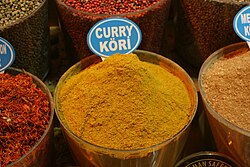Curry powder/ja: Difference between revisions
Created page with "インドのソースの風味を再現することを意図した既製の材料として考案され、" |
Created page with "大さじ1杯(6.3 g)の一般的なカレー粉には、USDAによると以下の栄養素が含まれている。 * 食物エネルギー: {{convert|20|kcal|kJ|order=flip|abbr=on}} * 脂質: 0.883 g * 炭水化物: 3.52 g * 食物繊維: 3.35 g * タンパク質: 0.9 g" Tags: Mobile edit Mobile web edit |
||
| (9 intermediate revisions by the same user not shown) | |||
| Line 23: | Line 23: | ||
西洋市場で商業的に入手可能なカレー粉は、伝統的なインドのスパイス混合物である[[garam masala/ja|''ガラムマサラ'']]('温かいスパイス'の意)に匹敵する。 | 西洋市場で商業的に入手可能なカレー粉は、伝統的なインドのスパイス混合物である[[garam masala/ja|''ガラムマサラ'']]('温かいスパイス'の意)に匹敵する。 | ||
インドのソースの風味を再現することを意図した既製の材料として考案され、最初にインドの商人がイギリスの貿易商に販売したものである。 | |||
カレー粉は18世紀のイギリスの料理本で材料として使用され、18世紀後半には市販されており、[[Wikipedia:Crosse & Blackwell|Crosse & Blackwell]]や[[Wikipedia:Sharwood's|Sharwood's]]などのブランドは現在まで存続している。オーストラリアでは、一般的なカレースパイスは[[:en:Keen's|キーンズ]]のカレー粉である。''カレー粉''という材料は、その製造方法の説明とともに、19世紀のアメリカやオーストラリアの料理本や広告にも見られる。 | |||
イギリスの貿易商は、19世紀中頃に[[:en:Meiji Restoration|明治]]時代の日本にこの粉を伝え、"[[Japanese curry/ja|日本のカレー]]"として知られるようになり、独特の料理へと発展した。 | |||
==語源== | |||
= | 西洋において、"curry"という言葉は、様々なインド料理を広く指す言葉である。これらはインド亜大陸で異なるスパイスの組み合わせで調理されたものである。この"curry"というソース状の要素は、[[:en:Tamil language|タミル語]]で文字通り「[[Sauce/ja|ソース]]」または「[[Relish for rice/ja|飯]]のおかず」を意味する''kaṟi''に由来しており、インド亜大陸で数千年かけて進化してきた''jhol''、''shorba''、''kalia''といった地方料理を指す他の地域的な表現と同義である。 | ||
=-材料{{Anchor|Ingredients}}== | |||
カレー粉には、いくつかの基準が定義されている。そのほとんどは、水分、灰分、油分などの分析要件や、許容される添加物について概説している。また、一部の基準では、いくつかの期待される成分も定義されている。 | |||
米国では、カレー粉には少なくとも[[turmeric/ja|ターメリック]]、[[coriander/ja|コリアンダー]]、[[fenugreek/ja|フェヌグリーク]]、[[cinnamon/ja|シナモン]]、[[cumin/ja|クミン]]、[[black pepper/ja|ブラックペッパー]]、[[ginger/ja|ジンジャー]]、[[cardamom/ja|カルダモン]]が含まれている必要がある。 | |||
1999年の東アフリカ規格(EAS 98:1999)では、必須成分の基準は定義されていない。ウガンダが2017年に作成した新しい草案では、ターメリック、コリアンダー、クミン、フェヌグリーク、マスタードが必須とされている。 | |||
インド(FSSAI)、パキスタン(PS:1741–1997)、および国際標準化機構(ISO 2253:1999)の各規格では、必須成分の基準は定義されていない。 | |||
< | <span id="Nutritional_information"></span> | ||
==Nutritional information== | ==栄養情報{{Anchor|Nutritional information}}== | ||
大さじ1杯(6.3 g)の一般的なカレー粉には、USDAによると以下の栄養素が含まれている。 | |||
* 食物エネルギー: {{convert|20|kcal|kJ|order=flip|abbr=on}} | |||
* | * 脂質: 0.883 g | ||
* | * 炭水化物: 3.52 g | ||
* | * 食物繊維: 3.35 g | ||
* | * タンパク質: 0.9 g | ||
* | |||
{{Herbs and spices/ja}} | {{Herbs and spices/ja}} | ||
Latest revision as of 19:55, 1 June 2025
| カレー粉 | |
|---|---|
 | |
| 種類 | カレー |
| 地域 | インド亜大陸 |
| 主な材料 | スパイス (コリアンダー, ターメリック, クミン, チリペッパー) |
カレー粉は、インド亜大陸発祥のカレー用のスパイスミックスであり、現地のスパイスミックスであるガラムマサラから派生したものであるが、それと混同してはならない。
歴史
西洋市場で商業的に入手可能なカレー粉は、伝統的なインドのスパイス混合物であるガラムマサラ('温かいスパイス'の意)に匹敵する。
インドのソースの風味を再現することを意図した既製の材料として考案され、最初にインドの商人がイギリスの貿易商に販売したものである。
カレー粉は18世紀のイギリスの料理本で材料として使用され、18世紀後半には市販されており、Crosse & BlackwellやSharwood'sなどのブランドは現在まで存続している。オーストラリアでは、一般的なカレースパイスはキーンズのカレー粉である。カレー粉という材料は、その製造方法の説明とともに、19世紀のアメリカやオーストラリアの料理本や広告にも見られる。
イギリスの貿易商は、19世紀中頃に明治時代の日本にこの粉を伝え、"日本のカレー"として知られるようになり、独特の料理へと発展した。
語源
西洋において、"curry"という言葉は、様々なインド料理を広く指す言葉である。これらはインド亜大陸で異なるスパイスの組み合わせで調理されたものである。この"curry"というソース状の要素は、タミル語で文字通り「ソース」または「飯のおかず」を意味するkaṟiに由来しており、インド亜大陸で数千年かけて進化してきたjhol、shorba、kaliaといった地方料理を指す他の地域的な表現と同義である。
-材料=
カレー粉には、いくつかの基準が定義されている。そのほとんどは、水分、灰分、油分などの分析要件や、許容される添加物について概説している。また、一部の基準では、いくつかの期待される成分も定義されている。
米国では、カレー粉には少なくともターメリック、コリアンダー、フェヌグリーク、シナモン、クミン、ブラックペッパー、ジンジャー、カルダモンが含まれている必要がある。
1999年の東アフリカ規格(EAS 98:1999)では、必須成分の基準は定義されていない。ウガンダが2017年に作成した新しい草案では、ターメリック、コリアンダー、クミン、フェヌグリーク、マスタードが必須とされている。
インド(FSSAI)、パキスタン(PS:1741–1997)、および国際標準化機構(ISO 2253:1999)の各規格では、必須成分の基準は定義されていない。
栄養情報
大さじ1杯(6.3 g)の一般的なカレー粉には、USDAによると以下の栄養素が含まれている。
- 食物エネルギー: 84 kJ (20 kcal)
- 脂質: 0.883 g
- 炭水化物: 3.52 g
- 食物繊維: 3.35 g
- タンパク質: 0.9 g
| この記事は、クリエイティブ・コモンズ・表示・継承ライセンス3.0のもとで公表されたウィキペディアの項目Curry powder(30 April 2025, at 18:07編集記事参照)を翻訳して二次利用しています。 |